Kneel at the crossroads of sacred divisions in the Bible, where every split whispers secrets of unity and discord awaiting discovery.
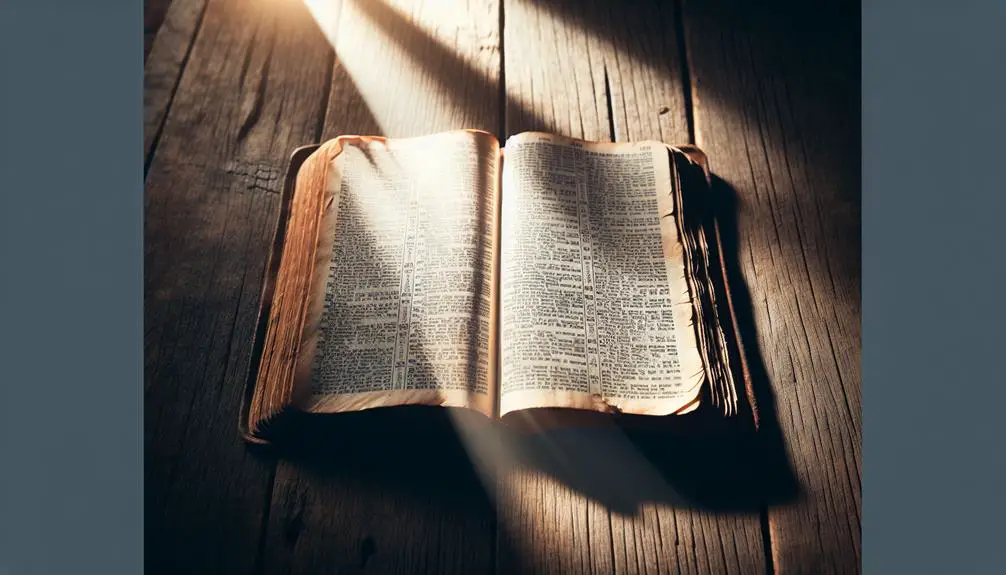
Divide in the Bible
Imagine standing at the edge of the Red Sea, witnessing the waters parting—a vivid portrayal of division that's echoed throughout the Bible.
You've encountered these divides, from the separation of light from darkness at creation to the walls of Jericho marking a clear boundary.
The concept of division, both physical and spiritual, weaves a complex tapestry in biblical narratives.
As you ponder these moments, consider how they reflect not just historical or mythological divides, but also the profound moral and ethical separations that challenge us.
What might these stories reveal about the nature of division and unity in your own life?
Key Takeaways
- Biblical divisions symbolize spiritual and moral distinctions, such as good versus evil and divine intervention versus human strength.
- Divine judgment determines eternal destinies, emphasizing the importance of moral and spiritual choices in life.
- The allocation of the Promised Land among tribes represents the fulfillment of divine promises and the transition to a settled covenant community.
- Events like the parting of the Red Sea and the fall of Jericho highlight divine intervention and the power of faith over physical obstacles.
Creation: Dividing Light From Darkness

How does the act of dividing light from darkness in the creation narrative symbolize fundamental biblical themes of order and chaos, good and evil? This division is among the first acts of creation described in Genesis, signifying its foundational role in biblical cosmology. The separation of light from darkness epitomizes the biblical conceptualization of order emerging from chaos. It's not just a physical act but a deeply symbolic gesture underscoring the establishment of a harmonious, structured world from a formless void. This act serves as a metaphor for the ongoing struggle between good and evil, illuminating the path for moral and spiritual guidance within the biblical text.
From a scholarly perspective, this division also represents the Bible's engagement with early scientific understandings of the world. Ancient civilizations perceived light as a primary element, essential for life and growth, embodying order and goodness. Darkness, in contrast, was often associated with chaos and evil, a void needing to be structured and illuminated. The act of dividing these two elements underscores a universal longing for order amidst the chaos, a theme resonating with human experience across cultures and epochs.
Delving deeper, the symbolic meanings attributed to light and darkness extend beyond their immediate biblical context. They reflect a broader philosophical inquiry into the nature of existence, the origins of the universe, and humanity's place within it. This narrative, therefore, operates on multiple levels, merging theological doctrines with existential questions, rooted in both ancient wisdom and nascent scientific perspectives.
The Parting of the Red Sea
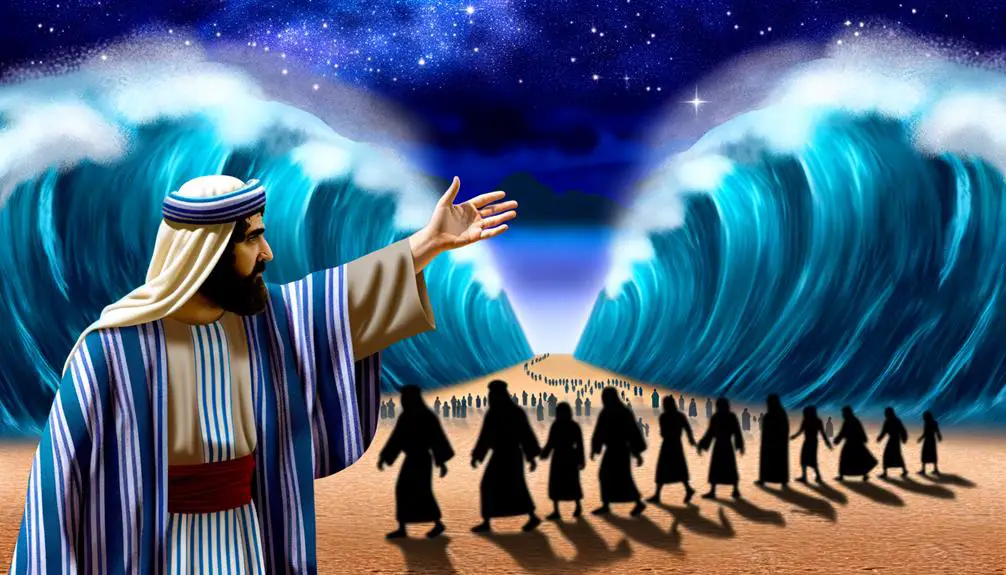
The parting of the Red Sea stands as a pivotal moment in biblical narrative, symbolizing divine intervention and the liberation of the Israelites from Egyptian bondage. You'll find that this event isn't just a miraculous feat of divine power, but also a profound faith demonstration by Moses and the Israelites. It's a story that intricately combines elements of faith, fear, and ultimate salvation, showcasing a miraculous navigation through what appeared to be an insurmountable obstacle.
At its core, the parting of the Red Sea serves as a testament to the power of faith over fear. Moses, faced with the encroaching Egyptian army and the vast, impassable waters of the Red Sea, holds firm in his belief in God's promise of deliverance. This unwavering faith is met with a divine response that defies natural explanation: the waters of the sea part, providing a safe passage for the Israelites, while closing back over their pursuers, ensuring their escape from slavery.
Analyzing this event, you'd notice it's not just about the physical divide created in the waters, but also about the spiritual divide it represents. It's a demonstration of the clear distinction between those who place their faith in divine power and those who rely solely on human strength and wisdom. The miraculous navigation through the Red Sea underscores a broader theme of reliance on divine guidance to navigate life's challenges.
In essence, the parting of the Red Sea encapsulates a moment of ultimate faith demonstration, where belief in divine providence leads to miraculous outcomes. It's a powerful reminder of the potential of faith to bring about liberation and deliverance, even in the most desperate circumstances.
Division of the Promised Land
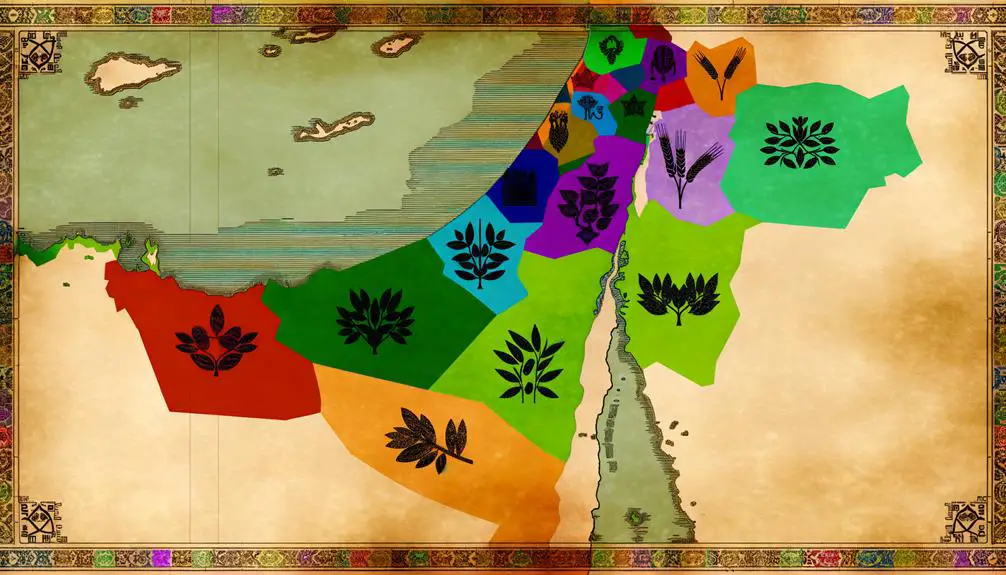
Upon entering the Promised Land, the Israelites faced the monumental task of dividing it among the twelve tribes, a process that not only allocated territory but also signified the fulfillment of divine promises and the complexities of establishing a unified nation. This division was meticulously recorded, underscoring its significance in Israelite history and theology. The narrative reveals not just an administrative activity but a deeply symbolic act, intertwining with themes of covenant, justice, and divine providence.
The allocation of tribal allotments was paramount in shaping the socio-political landscape of ancient Israel. Each tribe received a portion of land, except the Levites, whose inheritance was the Levitical cities and the offerings of the people. This division wasn't merely a matter of distributing real estate; it was about fulfilling the covenant promises made to Abraham, Isaac, and Jacob. It symbolized a new beginning, a transition from a nomadic existence to a settled life.
To engage further with this topic, consider the following aspects:
- Tribal Allotments: Each tribe's allotment wasn't random but based on divine instruction, considering the size, needs, and potential of each tribe. These allotments were crucial for the tribes' survival and prosperity.
- Levitical Cities: The Levites were allocated cities within other tribes' territories, emphasizing their unique role in religious and judicial matters. This arrangement ensured their support and facilitated the administration of justice and religious duties across the land.
- Symbolic Significance: The division of the land was laden with symbolic meaning, representing a tangible fulfillment of God's promises and a concrete foundation for the Israelites' identity as God's chosen people.
The division of the Promised Land was a complex process, deeply embedded in Israel's religious, cultural, and political fabric, reflecting its multifaceted significance in biblical history.
Walls of Jericho: A Separation
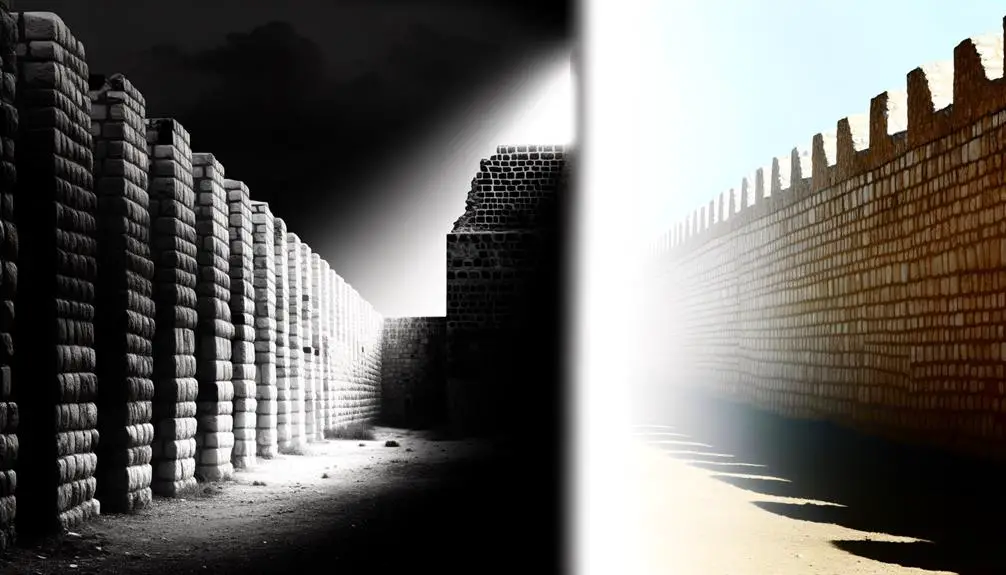
Shifting focus to the Walls of Jericho, we encounter not merely a physical barrier but a profound symbol of separation that both challenged and defined the Israelites' entry into the Promised Land. This ancient city's fortifications have sparked numerous archaeological debates, centering on their historical authenticity and what they represent in the biblical narrative.
The destruction of Jericho's walls, as described in the Book of Joshua, isn't just a tale of military conquest but deeply imbued with spiritual symbolism. These walls represented a formidable divide between the Israelites and their divinely promised future. It's essential to recognize that the fall of Jericho is often interpreted as a manifestation of divine will, transcending mere historical events to embody a theological lesson about faith, obedience, and the removal of barriers that separate humanity from God's promises.
Archaeological discussions around the Walls of Jericho have oscillated between skepticism and faith, with some scholars questioning the timing and even the existence of such monumental fortifications. Yet, regardless of these debates, the spiritual symbolism remains potent. The walls stand as a metaphor for obstacles in the believers' path that require divine intervention to overcome.
The Final Judgement: Eternal Division
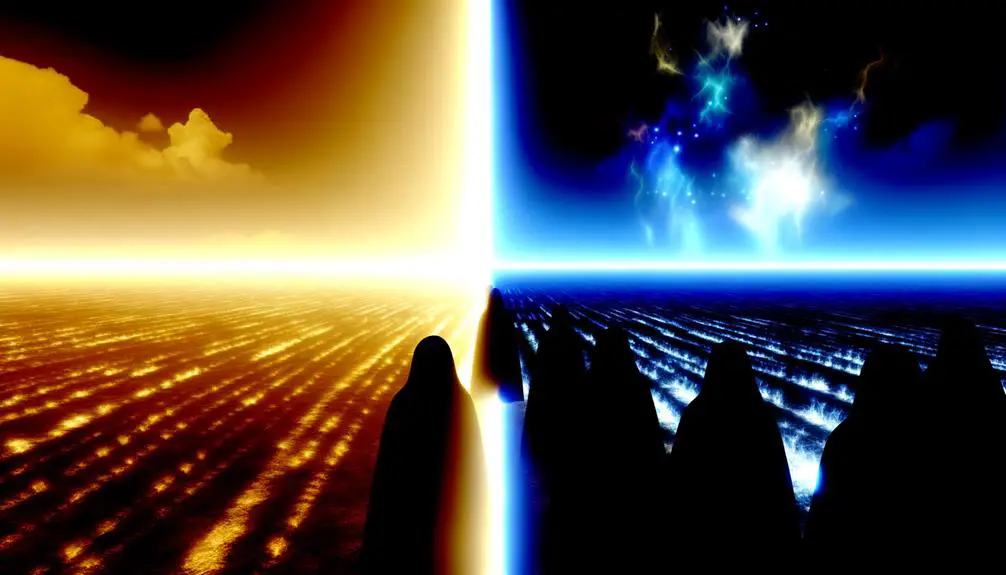
In biblical eschatology, Final Judgment embodies an ultimate division, delineating eternal destinies based on divine assessment of human deeds and faith. This momentous event signifies the culmination of earthly existence and the beginning of an everlasting fate, either in the presence of divine glory or separated from it.
The scripture lays out clear expectations for humanity, underscoring the importance of living a life in accordance with divine principles. At the heart of this doctrine are the concepts of heavenly rewards and sinful consequences, which serve as the ultimate motivators for moral and spiritual conduct.
To better understand the implications of the Final Judgment, consider the following points:
- Heavenly Rewards: You're promised eternal bliss and an unending fellowship with the divine. These rewards aren't merely gifts but acknowledgments of faith, perseverance, and righteousness. They represent the fulfillment of divine promises and the realization of an eternal covenant with believers.
- Sinful Consequences: The stark reality of Final Judgment is that sinful actions and rejection of divine grace lead to eternal separation from the Creator. This isn't simply a punishment but a natural outcome of a life lived in discord with divine will. Sinful consequences are the culmination of a path chosen away from divine guidance.
- Eternal Division: This division isn't arbitrary but is based on divine justice and mercy. It reflects a fundamental doctrine that one's earthly life and choices have eternal repercussions. The division underscores the gravity of moral and spiritual decisions, emphasizing the eternal nature of divine justice.
In essence, the Final Judgment stands as a testament to the divine principle of justice, offering both a warning and a promise, driving home the critical importance of choices made in this life.
Frequently Asked Questions
How Does the Concept of Division in the Bible Compare to Its Portrayal in Other Religious Texts?
When exploring division across religious texts, you'll find the Bible's treatment is unique yet shares cultural parallels and themes with other traditions. Through mythological analysis, you'll uncover that division often symbolizes moral or spiritual separation in these texts.
Unlike some narratives that emphasize reconciliation, the Bible sometimes presents division as a divine necessity. This comparative approach reveals underlying shared values among diverse faiths, despite the differences in their storytelling methods and theological interpretations.
What Are the Psychological and Moral Implications of the Divisions Mentioned in the Bible on Contemporary Society?
Imagine a community split over a moral issue, mirroring biblical divisions. These divisions impact society's psychological state, influencing social identity and challenging conflict resolution.
You'd see increased group cohesion within, but heightened tension between, fostering an us-versus-them mentality.
Analyzing this through a scholarly lens, it's clear that understanding and addressing the root biblical narratives can guide contemporary society towards more effective conflict resolution, promoting a healthier collective psyche.
Are There Instances Where Divisions in the Bible Symbolize Unity or Reconciliation Rather Than Separation?
Yes, divisions in biblical texts often symbolize unity or reconciliation. Consider the story of Joseph and his brothers; their initial division, driven by jealousy, eventually leads to a divine separation.
This separation, however, sets the stage for a powerful reunion and covenantal unity, showcasing how divisions can ultimately foster greater unity.
This narrative illustrates the complex interplay between separation and reconciliation, highlighting the multifaceted nature of biblical divisions.
How Have Interpretations of Biblical Divisions Evolved Over Time Within Different Christian Denominations?
As you dive into this topic, remember 'time heals all wounds.'
Over the years, interpretations of biblical divisions have morphed significantly across Christian denominations. Through ecumenical dialogues, once rigid denominational identities have softened, fostering a sense of unity even amidst theological differences.
These discussions haven't only bridged gaps but also enriched the understanding of scripture, showing that division can indeed lead to a deeper appreciation of faith's diversity and complexity.
In What Ways Have Artists, Musicians, and Writers Been Inspired by the Theme of Division in the Bible to Create Their Works?
You've seen how musical adaptations and artistic interpretations draw deeply from themes of division, weaving these narratives into their creations.
Artists, musicians, and writers delve into these motifs, crafting works that reflect, challenge, and expand upon the original biblical stories.
Their endeavors offer fresh perspectives, transforming ancient divisions into contemporary reflections.
Through their art, these creators engage in a dialogue with the past, bringing timeless themes into the present with creativity and insight.
Conclusion
In conclusion, the Bible brilliantly bridges the concept of division, demonstrating divine discernment from the dawn of creation to the decisive Day of Judgement.
Through timeless tales like the parting of the Red Sea and the partitioning of the Promised Land, scripture skillfully shows separation as a symbol of salvation and sovereignty.
These narratives not only narrate a physical divide but delve deeper into the dichotomy of darkness and light, ultimately underscoring the eternal essence of spiritual segregation.



Sign up